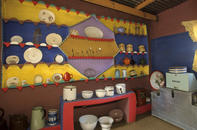- Home
- Art
- Art of South Africas Rural Communities
- Household Artefacts
- Carved Vessels
- Replacement of Old Vessels
In the course of the 20th century, plastic, ceramic and enamel containers gradually replaced the use of vessels woven from grass or carved from wood.

Enamel-coated metal cookware, first developed in Germany in the 18th century, became popular among rural communities as access to disposable income increased, especially after migrants began to work on the mines and in large cities.
In addition to pots, plates and bowls, which were valued in part because they are comparatively durable, families in outlying areas relied on jugs of boiled water poured into large enamel basins to clean themselves. Lidded enamel pots were also used to store the water used for drinking and cooking.

At a ceremony to thank the ancestors for their on-going protection, held in the Umfolozi valley in the mid-1980s, a homestead’s head, his two wives and other members of the family entered their compound, some carrying plastic buckets with freshly brewed beer on their heads.
The beer was subsequently decanted into clay pots before being consumed by the family and their guests. All members of the independent Shembe church, on this occasion the family also honoured their faith in Jesus Christ.
Plastic buckets are a fairly recent invention. First introduced to consumers through the food industry in the late 1960s, those used to package paint and other industrial products soon became prized items that to this day are recycled by rural communities for a variety of purposes, including the storage of both liquids and dry goods.